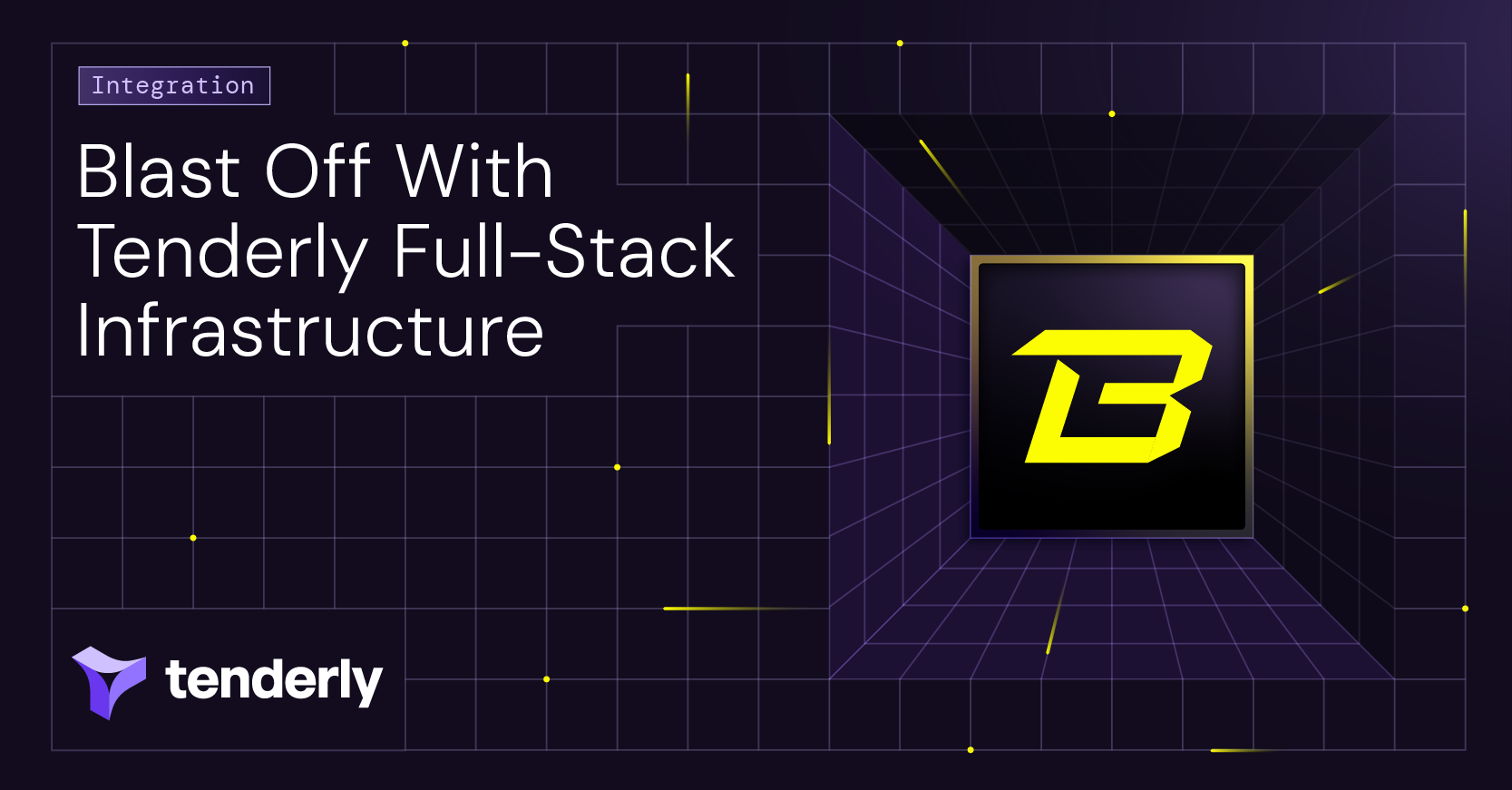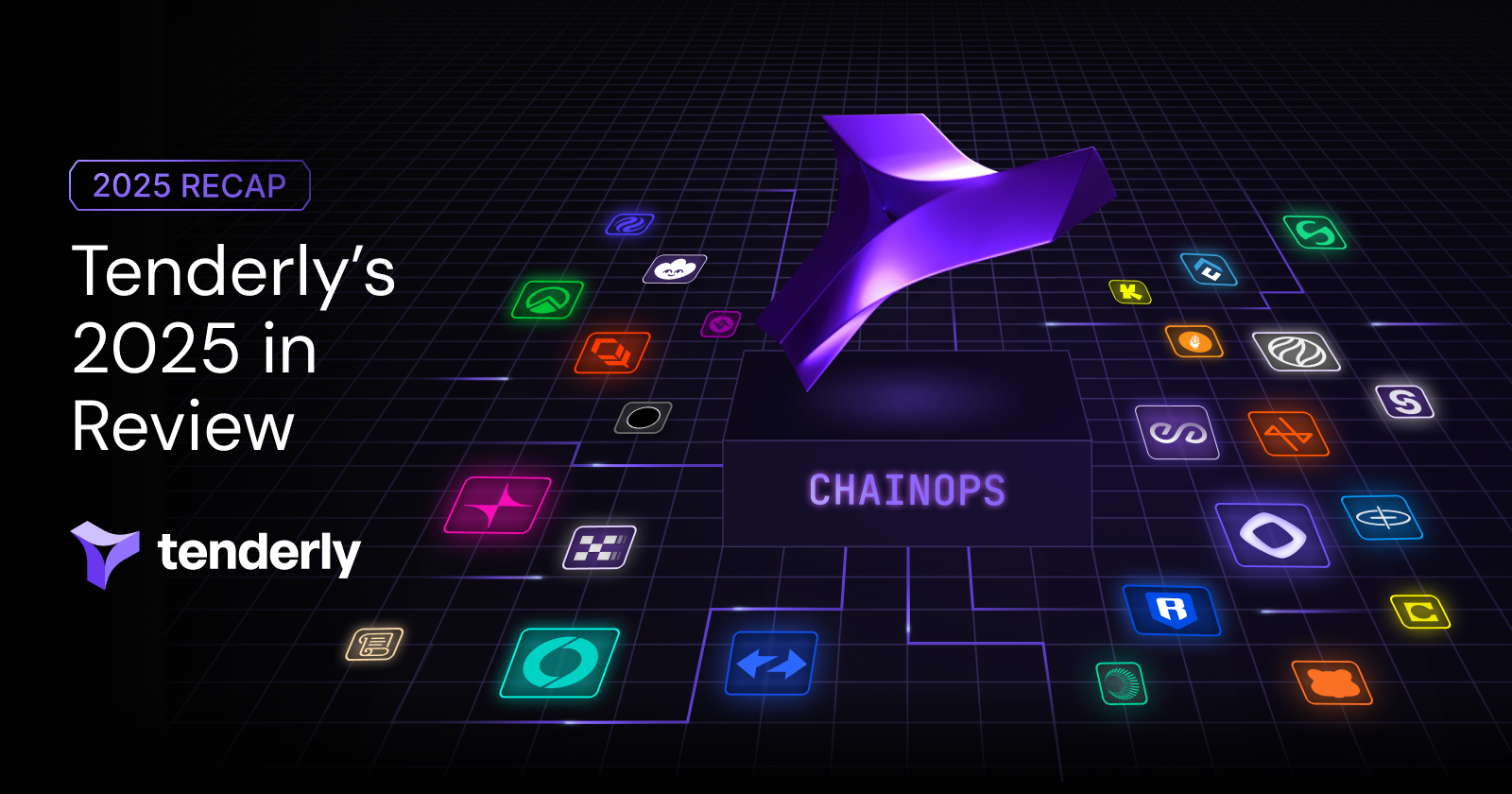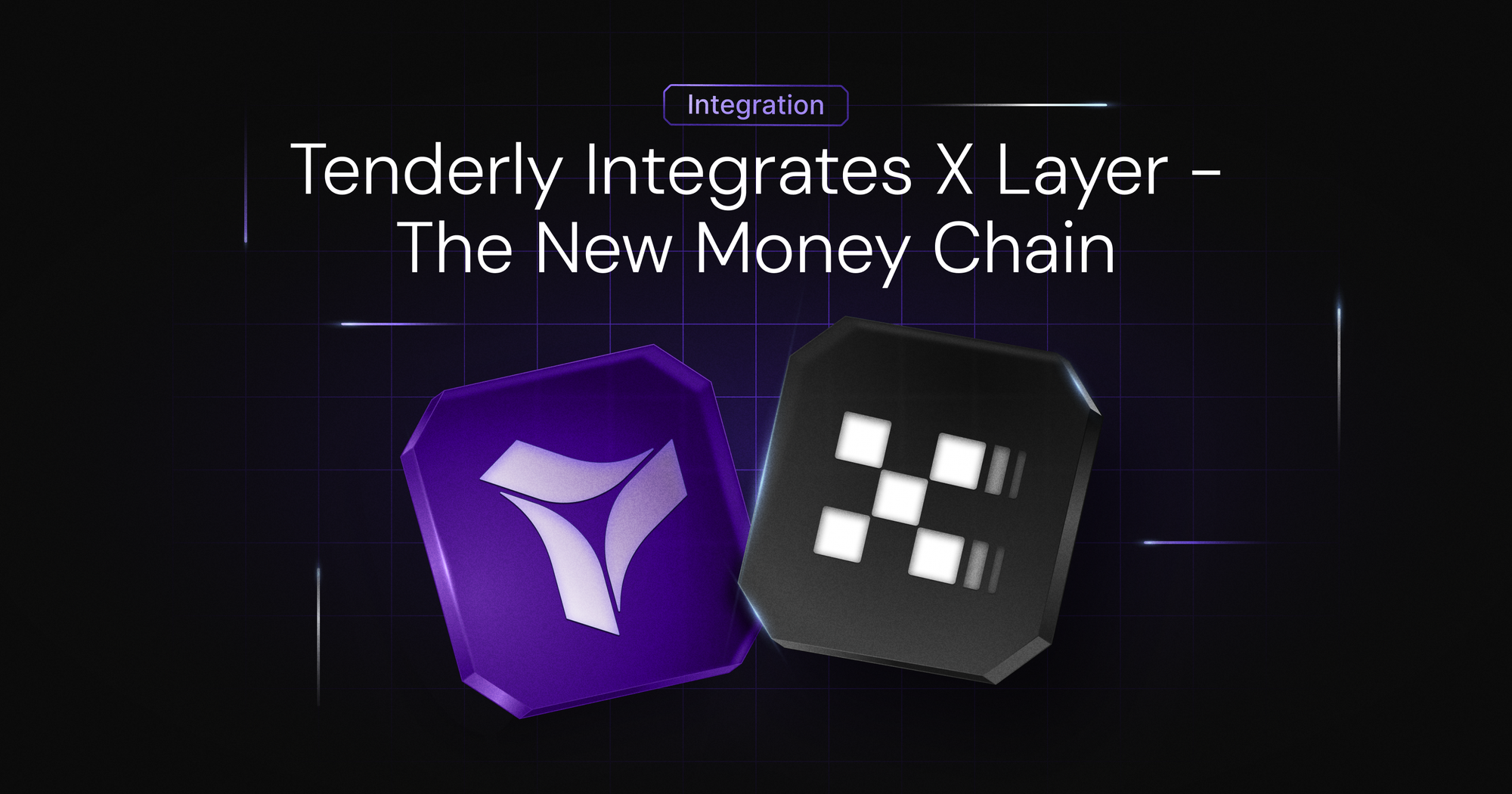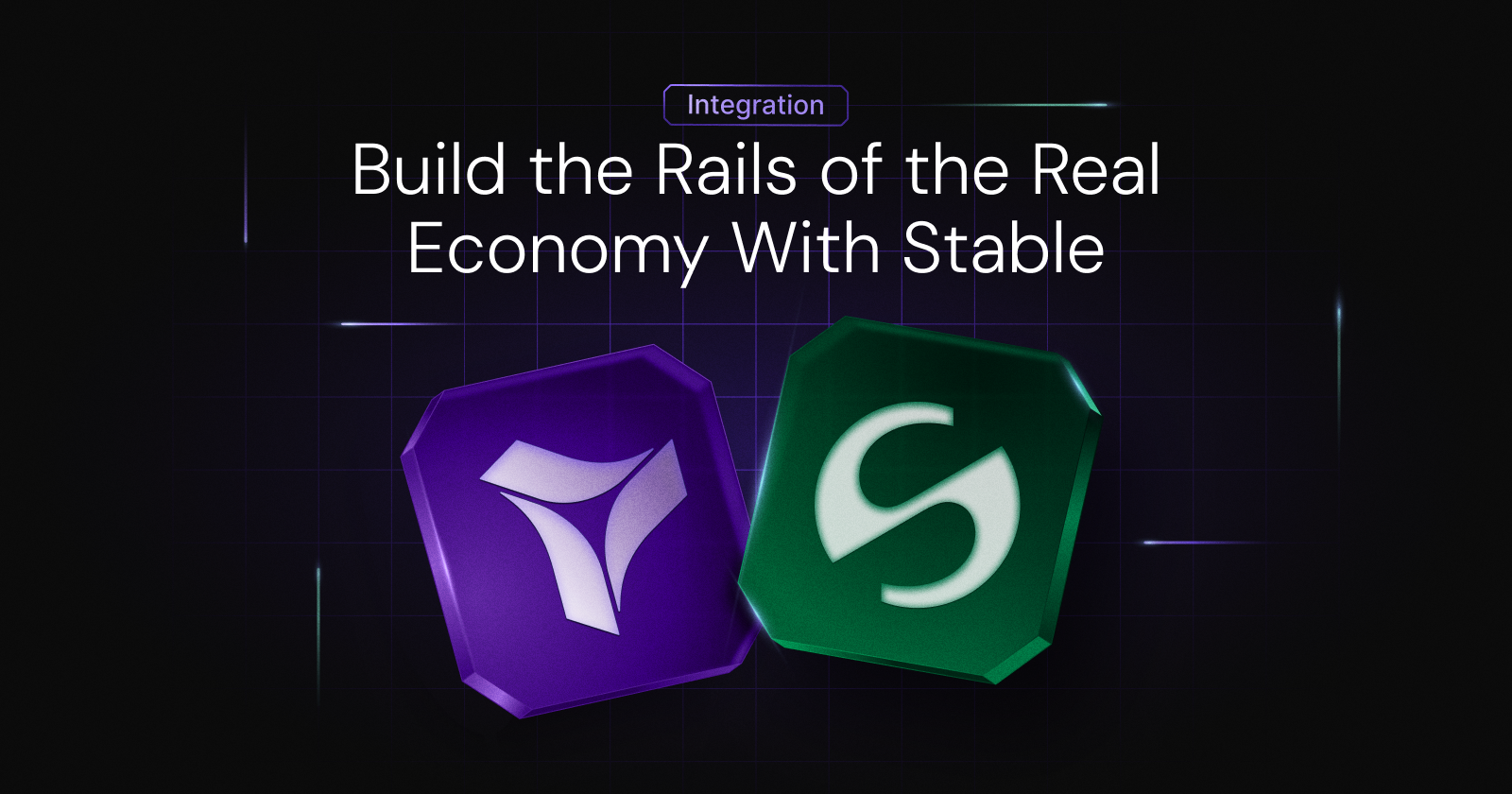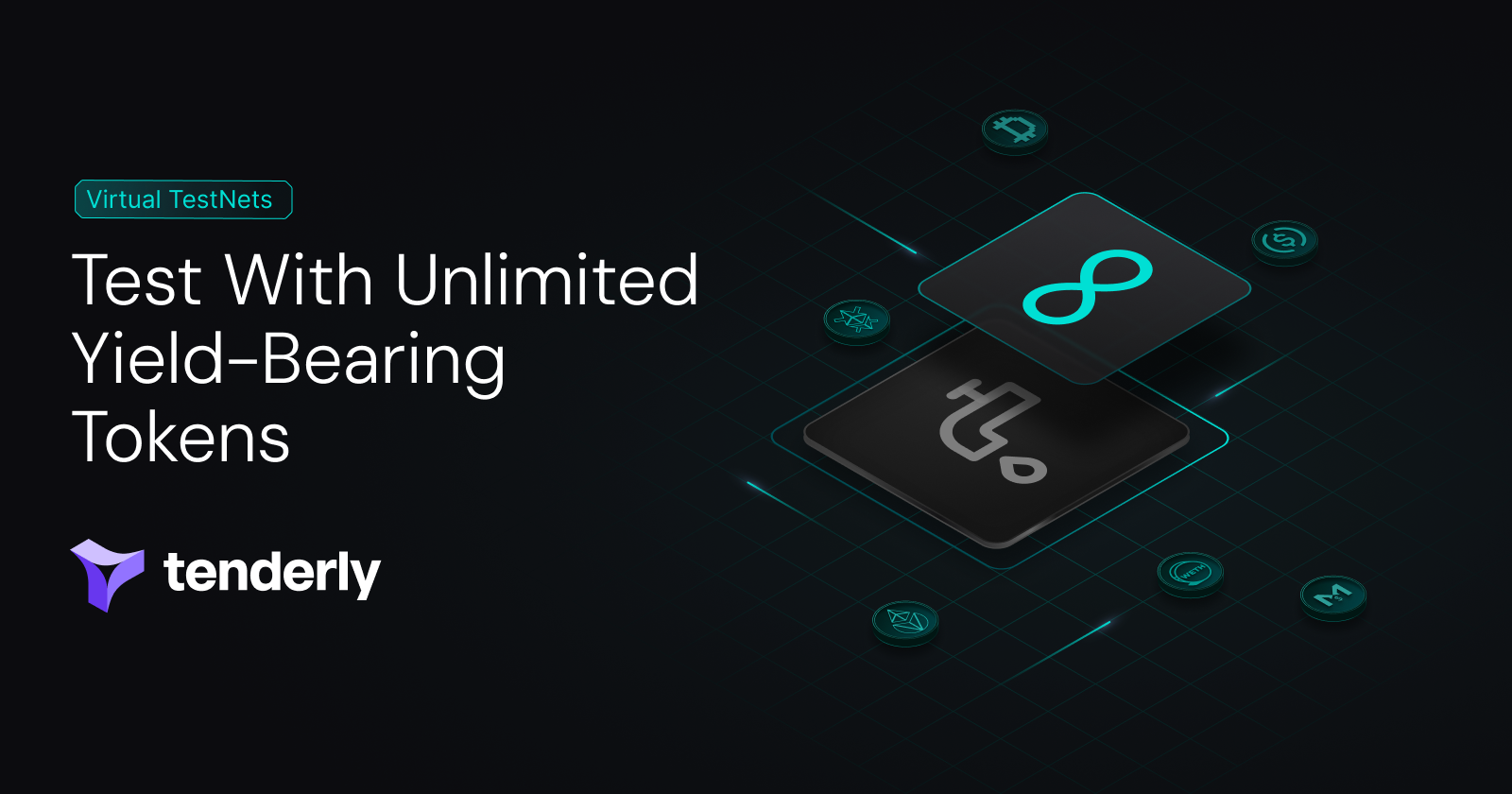Blast is an EVM-compatible Layer 2 optimistic rollup built on the Ethereum Mainnet. The main idea behind the creation of the Blast network was to build a more capital-efficient L2 where users earn yield on ETH and stables by default. Blast is the only Ethereum L2 focused primarily on native yield generation through several mechanisms, including auto-rebasing, L1 staking, and collaboration with real-world asset protocols. Built on the principles of market efficiency, stablecoin assets deposited to Blast are automatically converted to USDB, Blast's auto-rebasing stablecoin.
As an EVM equivalent network and part of the broader Ethereum ecosystem, Blast enables you to build dapps by relying on already existing and familiar code. You can migrate dapps from other blockchain networks to Blast without any modifications.
Not only that, but all of the tools and infrastructure you’re used to work natively on Blast. You can now use Tenderly’s full-stack infrastructure and industry-recognized tools for the entire dapp lifecycle on Blast. With Tenderly’s support, your Web3 development experience is going to be a blast!
The growing Blast ecosystem
The Blast team bootstrapped the development of Blast by offering users to bridge and deposit assets, resulting in the highest bridged amount before launching the mainnet blockchain. The massive launch campaign attracted DeFi users far and wide and became one of the most successful Layer 2 rollup network launches.
Blast's appeal was significant in the months before the launch due to the ease with which users could bridge assets to the network and immediately and automatically start generating yield. Blast's mission to earn more yield/ETH/USD for users was simple, straightforward, and easy to understand to the Web3 community, making it so appealing that it drew in $2.3B in assets before the launch of the mainnet. Blast is the second L2 by dapp TVL with over $1.9B in dapp TVL.
That high mark speaks volumes. The number of active addresses crossed the 100K mark, while the number of unique addresses on the network surpassed 1M. Alongside the stable growth in the number of transactions, the cost of transacting on the network has decreased significantly following the Dencun upgrade.
The high number of potential new users seeking yield attracted many developers. With over 200K active contracts deployed, averaging 3K deployed contracts daily, developer activity on Blast continuously grows with its DeFi ecosystem. Blast’s Big Bang developer contest attracted over 3000 teams battling for a place in the network’s incentive program.
The DeFi protocols with the most users are the native DEX Thruster, the leveraged farming dapp Juice Finance, the yield farming protocol Hyperlock Finance, liquid restaking Renzo, and the lending Orbit protocol. Additionally, some developer contest winners have already achieved significant usage. Web3 games such as Fantasy, District One, and Captain & Company are setting some new on-chain records.
Build with Yield: Blast’s vision for the ecosystem
The vision for the Blast network is to provide users with a direct and simple way to generate yield from assets. To create a yield-focused DeFi ecosystem, the Blast team also created some long-term benefits for developers to appeal to builders developing new products and ways to utilize Blast’s yield focus.
To use Blast’s native yield, users simply need to transfer their assets to Blast and hold ETH or USDB tokens to accrue yield. They can do that via Blast’s UI, created for this purpose, though third-party bridges are also available.
After the deposit is mined and the Blast sequencer indexes the transaction, the balance appears on the Blast network. Blast’s yield generation for its users is based on two key components:
- Users deposit their ETH and, in doing so, support the network’s security and operations, receiving rewards in the form of more ETH. Blast is currently the only Ethereum L2 rollup that directly passes the staking yield to users. The default interest rate for ETH is ~4%.
- The stablecoin assets bridged to Blast are automatically deposited to the Treasury Bill protocols, such as the MakerDAO vaults. The default interest rate for deposited stablecoin assets is ~8%.
Although using user funds in external protocols introduces some systemic risks, Blast’s initial choice of industry leaders like MakerDAO and Lido is enough to calm any immediate qualms or concerns.
Even though it was recently launched, it’s no wonder Blast boasts a sprawling DeFi ecosystem with over a hundred protocols in a short time frame, including DEXes, yield farming, liquid staking, lending, and other DeFi protocols.
Why should developers build on the network?
Blast’s native yield focus is a fairly new concept and is unique among other L2 solutions and enables dapps to build competitive products and business models. Alongside the promise of helping scale Ethereum, Blast appeals to users seeking passive income and offers additional liquidity. Both make the network more attractive to developers deciding on the new or next chain to deploy their dapp.
The yield-focused network incentivizes dapp development and attracts developers to build their products on the platform by offering significant benefits:
- Gas fee revenue: 100% of gas fees are programmatically given back to developers to use for their development or as a subsidy to attract users.
- Airdrop: 50% of Blast token airdrop is reserved for builders and developers expanding the yield ecosystem.
- Native yield: Using a pre-built network configuration focused on the yield primitive for bridged assets, dapps launched on the network can make use of these deposits to create new business and monetization models.
How to Blast off with Tenderly?
Tenderly’s full-stack infrastructure equips you with the necessary components and tools for the entire dapp lifecycle. You can move fast from development to on-chain deployment with the only node RPC with built-in development environments and essential tools.
Here’s how to prepare for takeoff and make your Blast experience as smooth as possible with Tenderly.
1. Set up your production and development infrastructure
Tenderly’s full-stack infrastructure gives you the first building block – a production node that offers reliable performance and fast access to the Blast network via RPC. However, with Tenderly Node, you get more than just a Blast RPC. Our full-stack node is fully integrated with the rest of our infrastructure and development tools. It’s the only RPC with embedded development environments and built-in debugging and exploration tools for the entire dapp lifecycle.
Additionally, with managed node infrastructure, you can deploy smart contracts, send transactions, and query data without running your own node. In addition to the standard RPC methods, Tenderly Node provides custom RPC methods to speed up your development, provide more visibility, or enhance your dapp functionality.
You can interact with Blast by relying on Tenderly’s multiregional support, stable connection, and fast response time via either HTTP or WebSocket access.

2. Set up collaborative development environments with Blast’s on-chain data
With recently launched Virtual TestNets, collaborative development infrastructure, you no longer need to rely on public testnets for dapp development. Lacking the mainnet data and smart contracts necessary to test with, especially in the case of DeFi protocols, public testnets don’t replicate the exact conditions of a production environment. Plus, they also come with network congestion and token shortages, hindering your dapp development.
Designed to replace public testnets, Virtual TestNets are synced with the latest state of the Blast chain. They’re also easily adaptable to any unique and existing team workflow, including CI, dapp staging, and public testing.
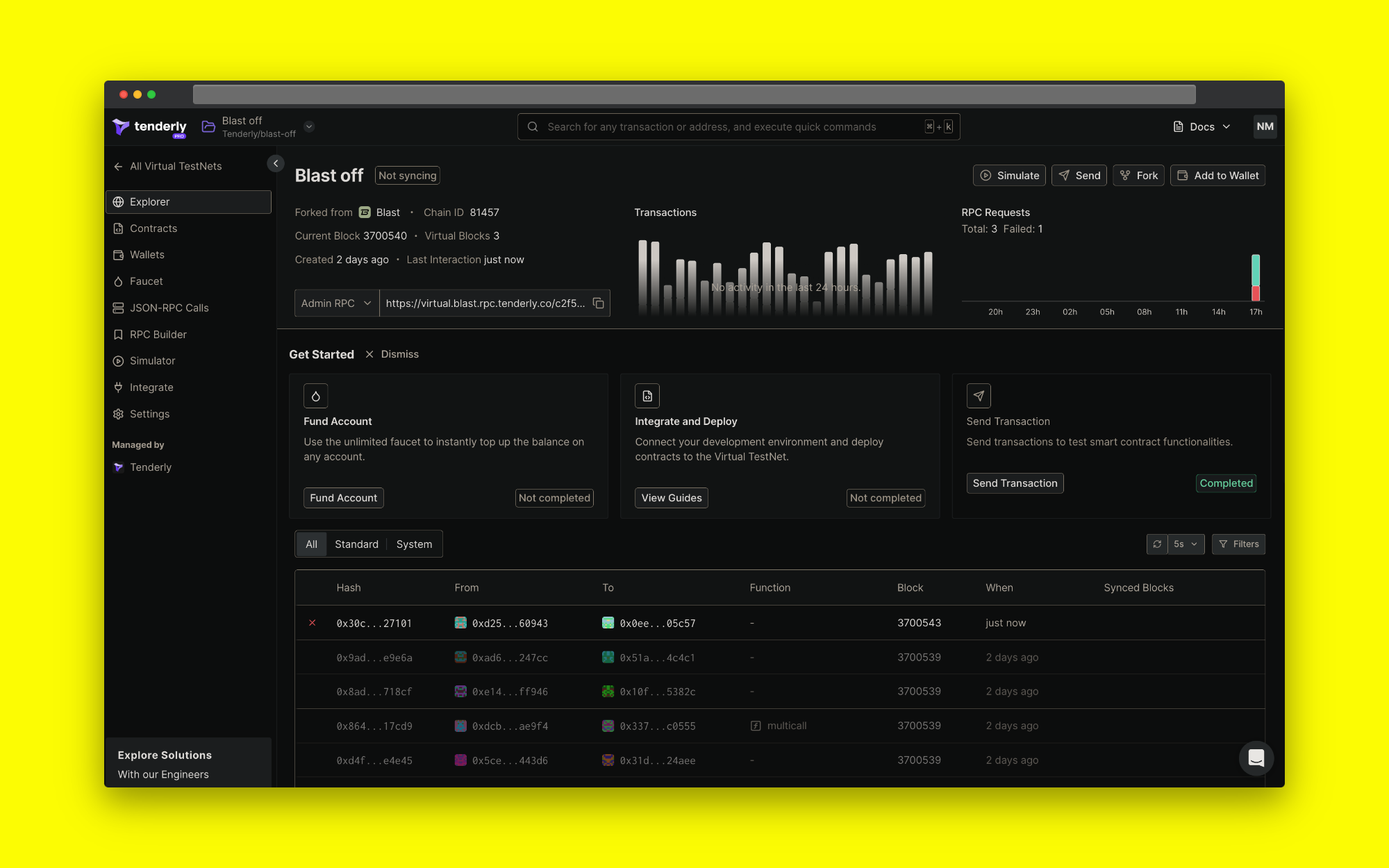
Fork the Blast chain to spin up your own replica of the Blast network and use it as your development and staging infrastructure. You can create and run separate instances in parallel for your teams working on Solidity, backend, or frontend components. This way, they can develop with minimal cross-team interference while still having collaborative tools and shareable environments.
Virtual TestNets bring you some essential functionalities, including:
- State Sync to keep the state of your TestNet in real-time sync with the Blast mainnet.
- Private TestNet Explorer offering essential insights into transactional activity on your network replica.
- An unlimited faucet for ERC-20 and native tokens that you can use to fund any account.
- Contract deployment and verification from your existing frameworks such as HardHat and Foundry.
- Public and Admin RPCs that you can use for public sharing and network customization via custom RPC methods, respectively.
- Built-in debugging tools, including Debugger, Gas Profiler, and Simulator to troubleshoot bugs, override contract states, analyze gas, and validate fixes.
For a limited time Virtual TestNets are available to everyone and free to use! Try them out now!
3. Explore and debug on-chain data with the essential developer tools
By integrating high-performance Tenderly Node, you also get industry-leading Web3 debugging and explorations tools for complete observability into dapp-relevant data and improved efficiency.
- Preview and inspect transactions trace by trace to perform a detailed analysis of executed transactions. Get a human-readable overview of transaction execution, including key status information, full stack trace, state changes, contracts involved, emitted events, and gas consumption.
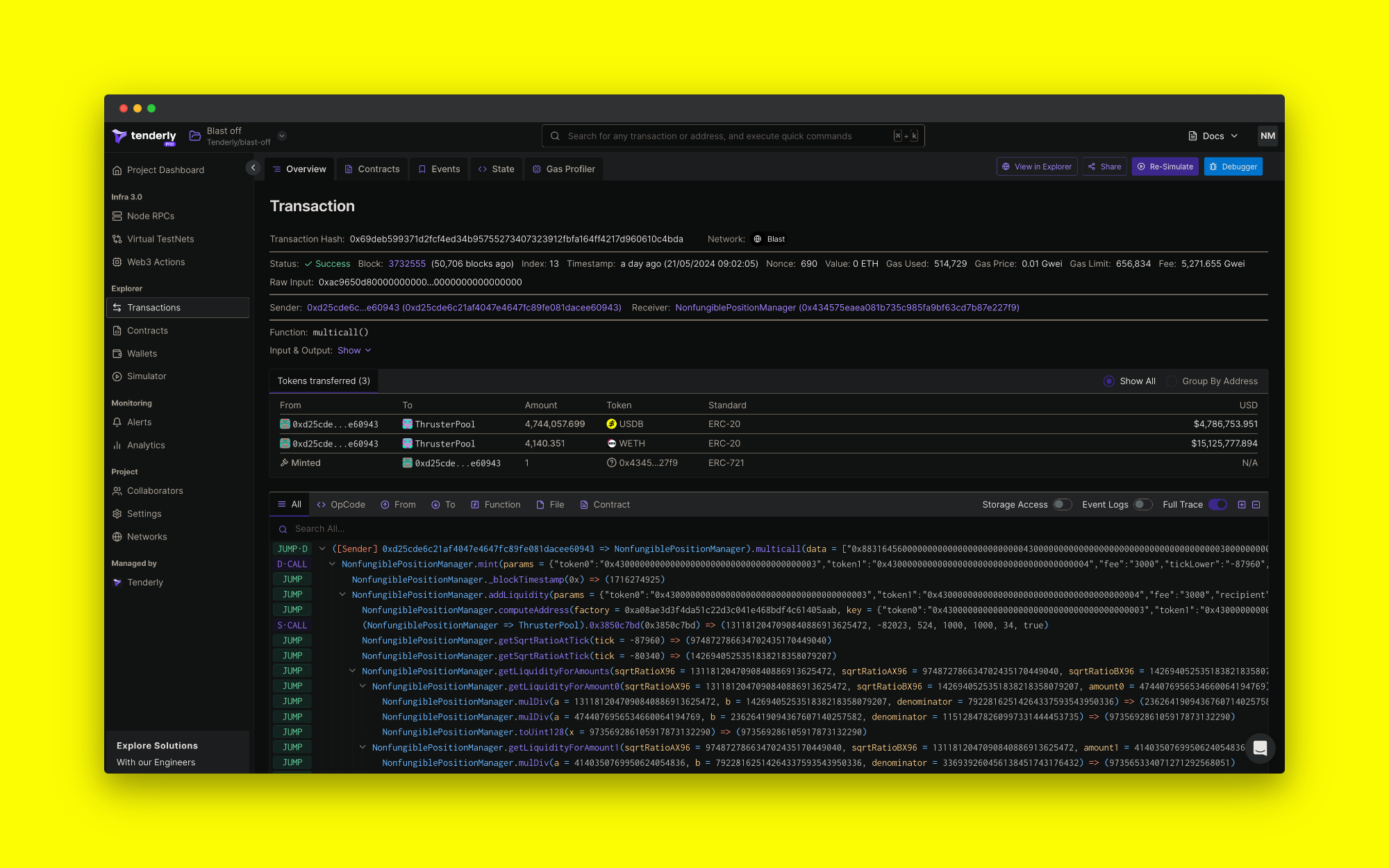
- Debug issues and validate bug fixes instantly. Dive even deeper into transaction execution with the most granular Debugger. Analyze the entire stack trace and identify the exact line of code where a bug occurred. Then, use Transaction Simulator to resimulate the execution with modified parameters or updated contract state to try out your fix.

- Optimize gas consumption by analyzing the gas usage of any transaction, breaking it down to individual function calls.
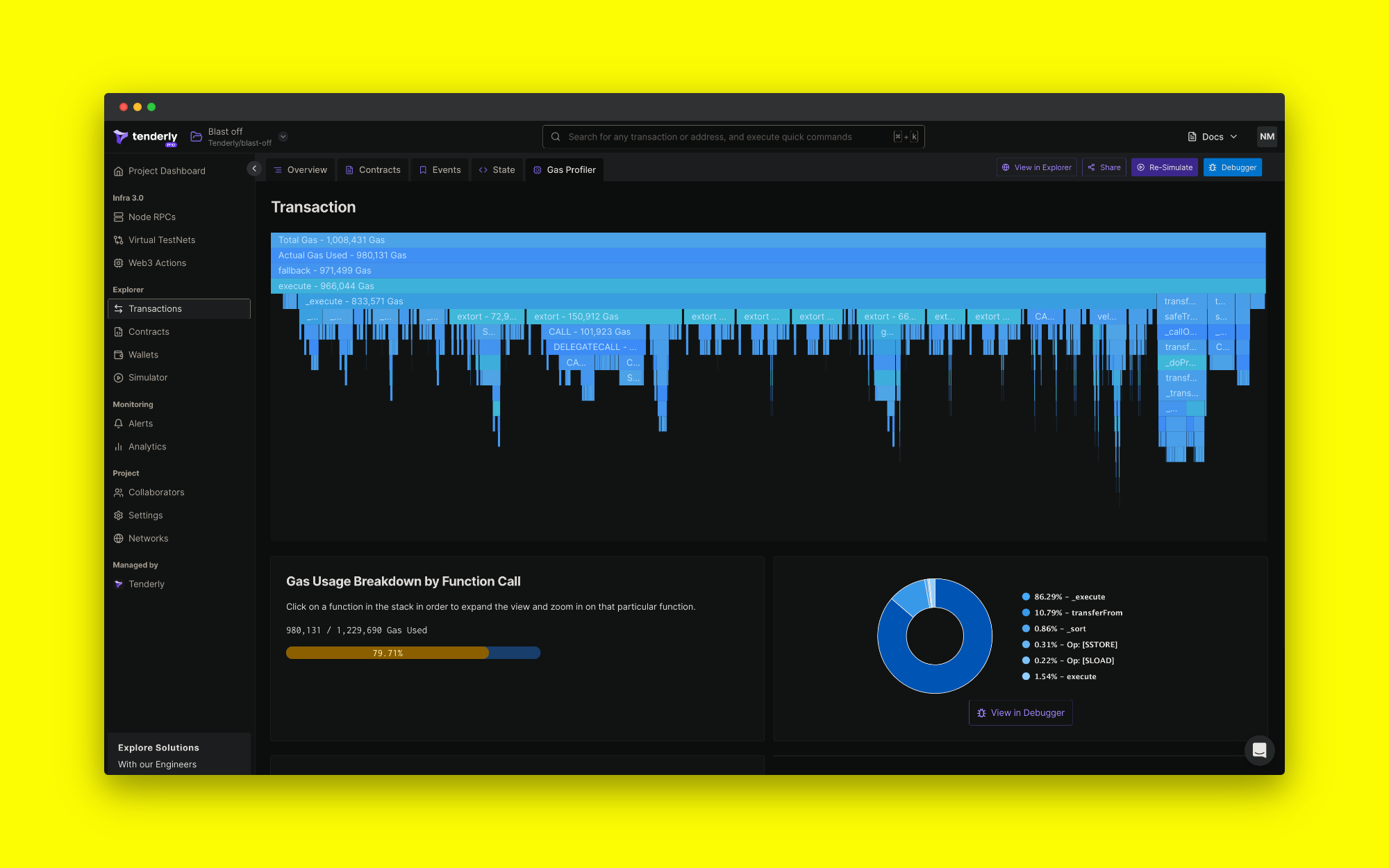
4. Monitor and respond to on-chain events on Blast
With Tenderly, you can closely monitor relevant on-chain events on Blast. To stay up to date with any crucial event relevant to your dapp, you can:
- Receive real-time alert notifications on various on-chain activities on Blast. You can stay up-to-date with the behavior of your dapp based on triggers ranging from successful and failed transactions, specific functions called, events emitted, or token transfers, among many others.
After defining the trigger, you can choose whether to receive alerts on specific addresses, the whole Blast network, or even blocked/allowlisted user addresses.
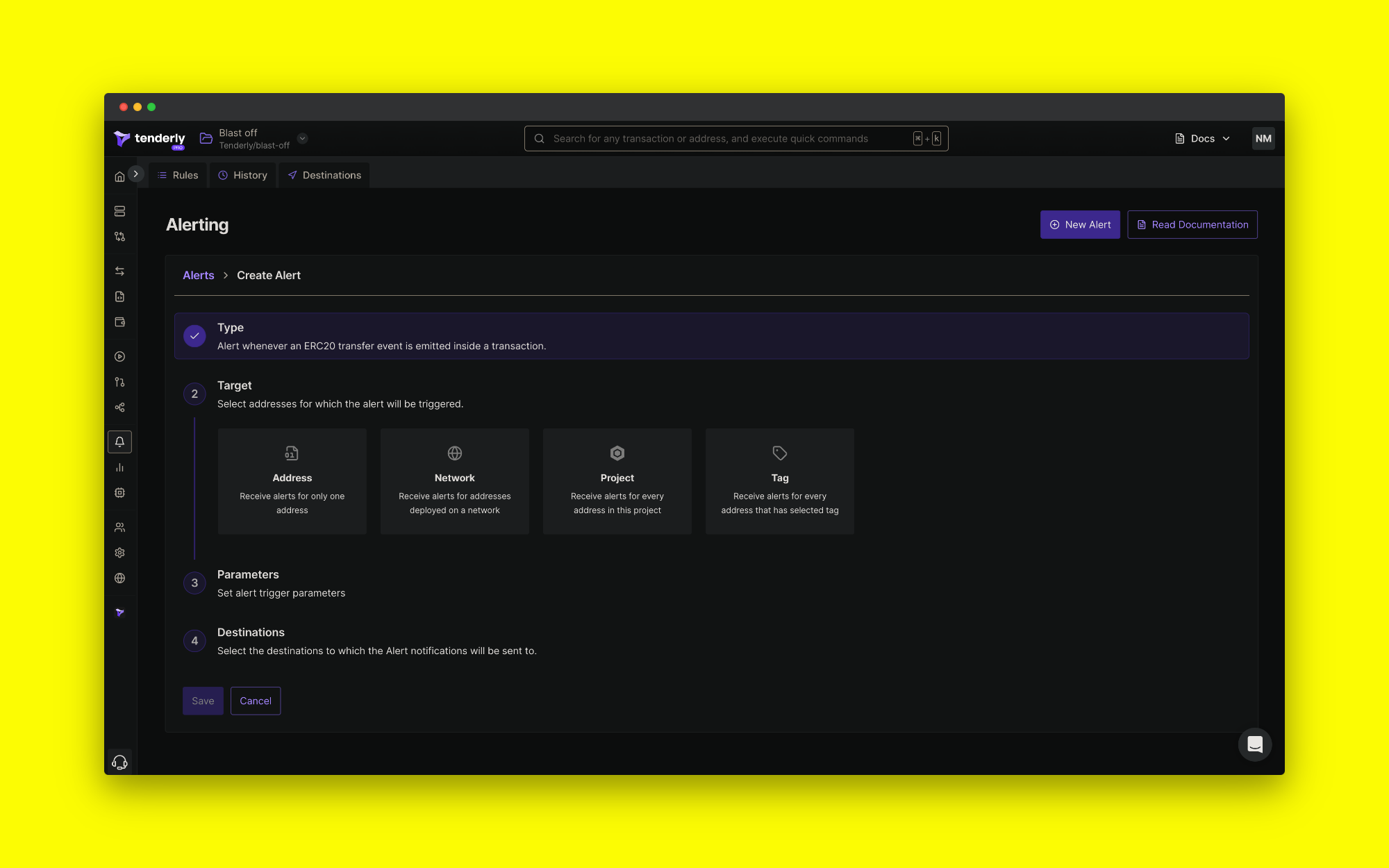
- Respond to on-chain notifications using Tenderly Alerting in combination with Web3 Actions. You can create your own automated incident management system, responding to on-chain events automatically with a custom code set to execute based on the set triggers.
Web3 Actions allow you to go beyond a simple alerting system and create an automated event-handling system based on blocks mined, webhooks, or specified intervals.
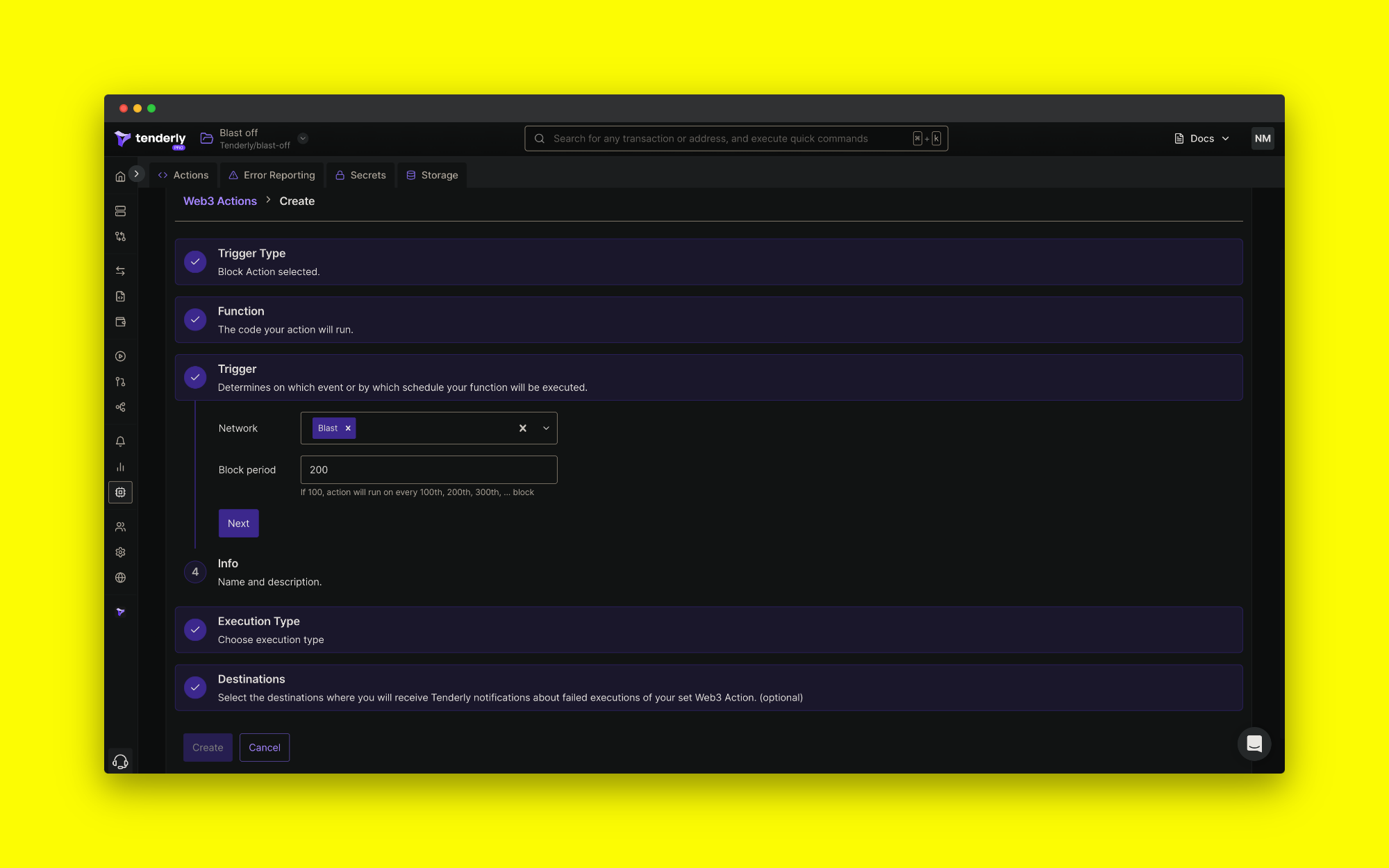
Get ready for Tenderly Blast off!
Through its numerous incentive programs, Blast offers significant benefits to users but especially to developers deciding to deploy on the new yield L2, with substantial airdrop dev allocation. As an L2 built on top of Ethereum, it solidified its place in the EVM multichain ecosystem, helping it scale further as a yield-dedicated blockchain and home for DeFi yield innovation. Other EVM L2 benefits, including less congestion, lower fees, and tooling compatibility, set off its incredible launch.
After much anticipation and developer interest, the time to Blast off with Tenderly has finally arrived, with the entire full-stack infrastructure at your fingertips. Now, you can rely on the top-performing node RPC together with development infrastructure and essential tools to build and run dapps with ease on Blast.
Create your own Blast replica and start building. 🚀
